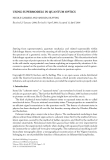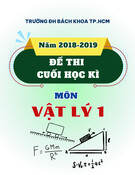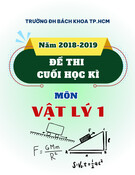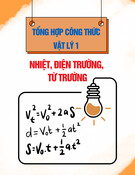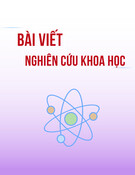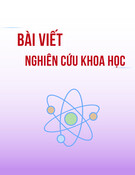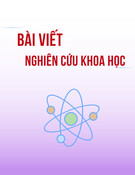Quantum Nature of Light (Quantum Optics)
Courtesy of N. Brunner and J. Simmonds
Pham Tan Thi, Ph.D. Department of Biomedical Engineering Faculty of Applied Sciences Ho Chi Minh University of Technology
Light behave like a wave or a particle (This is called the duality of the behavior of light)
Wave Characteristics
Electrically Charged Particles and Electromagnetic Waves
Electrons have (-) charge
Protons have (+) charge
Both have electric fields
+- attract
++ and -- repel
• The changing position of a charged
particle creates “waves” called electromagnetic waves
• The electromagnetic waves travel through empty space eventually interacting with a distant charged particle.
• Visible light is an electromagnetic
wave.
Magnetism (Effect on electric charges)
Moving electric charges also produce magnetic fields.
Example: electric current passing through a coil.
Another interesting example: the Earth’ magnetic field is produced by the spinning of charges in the liquid metal core of the Earth.
Conversely, magnetic field force charged particles to move…
Accelerated Charges (electrons, protons) Produce (Ripples in the Electromagnetic Field)
An electromagnetic wave is composed of two oscillating fields, and electric field and a magnetic field perpendicular to each other
Antenna receives electromagnetic signal from TV station
Wavelength of Electromagnetism means COLOR
The Temperature Scale (Conversion from wavelength/energy to temperature)
The scale mostly used in sciences, physics and astronomy is Kelvin. The unit is Kelvin (K).
Thermal Radiation
• The fundamental sources of all
electromagnetic radiation (EMR) are electric charges in accelerated motion.
• All bodies emit electromagnetic radiation
Reference #1
Reference #2 as a result of thermal motion of their molecules. This radiation, called thermal radiation, is a mixture of different wavelengths.
An electric heating element emits primarily infrared radiation. But if its temperature is high enough, it also emits a discernible amount of visible light.
• Thermal radiation is emitted by all objects above absolute zero (-273.15°); but some of objects is in visible.
What is a Blackbody
A blackbody is an idealized object that absorbs all EMR that falls on it - no EMR passes through it and none is reflected (i.e. perfect emitter and perfect absorber).
Leave appears green because green color is reflected to human eye
Because no light (visible EMR) is reflected or transmitted, the object appears black
Blackbody in Lab Experiment
• An object of controlled temperature T contains a cavity, joined to the
outside by a small hole.
• If the hole is small enough, the radiation in the cavity comes to
equilibrium in the walls.
• The hole allows a small fraction of the radiation to pass to a
spectrometer — the radiation coming out has the same spectrum as what is inside.
• The radiancy is the power emitted per unit area per increment of
wavelength and so has unit of Wcm-3
Blackbody in Lab Experiment
• The spectral radiance from the hole is independent of the material
used and only depends on the temperature.
Rayleigh - Jeans Approximation for Blackbody
Kirchhoff’s Law of Thermal Radiation in Thermal Equilibrium
Ultraviolet Catastrophe
Quantum Theory
1. Stefan-Boltzmann’s Law
2. Wien’s Law
3. Planck’s Theory
4. Planck’s Formula
Stefan - Boltzmann’s Law
M� = �T 4
The total emitted radiation (Mλ) from a blackbody is proportional to the fourth power of its absolute temperature.
where σ is the Stefan-Boltzmann constant, 5.6697 x 10-8 Wm-2K-4
—> the amount of energy emitted by an object such as the Sun or the Earth is a function of its temperature
1
—> This can be derived by integrating the spectral radiance over entire spectrum
L =
M� = ⇡L = �T 4
L�d� =
2⇡2k4 5c2h3 T 4
0
Z
OR
Wien’s Displacement Law
�max =
k T
In addition to computing the total amount of energy existing a theoretical blackbody such as the Sun, we can determine its dominant wavelength (λmax) based on Wien’s displacement law:
where k is the is the Wien’s displacement constant = 2.898 x 10-3 Km, and T is the absolute temperature in K
i.e. there is an inverse relationship between the wavelength of the peak of the emission of a blackbody and its temperature.
Therefore, as the Sun approximates a 6000 K blackbody, its dominant wavelength (λmax) is 0.48 µm
Planck’s Quantum Theory
Max Planck found a correct law for the black body radiation by assuming that each oscillator can only exchange energy in discrete portions or quanta
The energy exchanges between radiation and matter must be discrete and energy of radiation E = nhν
" =
h⌫ eh⌫/kT
1
�
Average energy per standing wave
⌫3d⌫
u(⌫)d⌫ =
8⇡h c2
eh⌫/kT
1
�
Planck’s modifications
h = 6.626 x 10-34 J.s is Planck’s constant
Einstein’s Theory of Photoelectric Effect (Provides a direct confirmation for the energy quantization of light)
Heinrich Hertz in 1887 later on, it was explained by Albert Einstein in 1905
It was during this study of electromagnetic waves that he saw the if one sends ultraviolet light onto metals, you’ll get sparks coming off.
The phenomenon of ejection of electron from the surface of a metal when light of a suitable frequency strikes it is called photoelectric effect. The emitted electrons are called photo-electrons.
Experiment:
The time between the incidence and emission of a photoelectron is very small, < 10-9 s.
Classically: raise intensity => more electrons
independent of frequency
Einstein’s Interpretation
E = h⌫
Light comes in packets of energy (photons)
An electron absorbs a single photon to leave the material
Work function: W = h⌫0
Larger W needs more energy needed for an electron to leave
Classical physics fails: for dependence of the effect on the threshold frequency
W = h⌫
h⌫0
�
�
Photoelectric effect: K = h⌫
The stopping potential: at which all of the electrons will be turned back before reaching the collector
Exercise 1 (estimation of the Planck constant
When two UV beams of wavelengths λ1 = 280 nm and λ2 = 490 nm fall on a lead surface, they produce photo-electrons with maximum kinetics energies 8.7 eV and 6.67 eV, respectively.
(a) Calculate the value of the Planck’s constant
(b) Calculate the work function and the cutoff frequency of lead
Can Reverse be True?
confirmation
of
1927 Nobel
Compton Effect/Scattering Further Compton effect photon model (Further confirmation of photon model) Compton scattering is another one of those really important events that happened at the beginning of the 20th century. It indicated that photons Compton scattering is another one of those really important events that happened at the beginning of the 20th century that indicated that photons were were really. They really do behave like a particle. real. They really, like really does behave like a particle.
collision
Large wave length
small wave length
2
(cid:32) hE (cid:32)
(cid:99) (cid:81) (cid:99) /(cid:81)
h
p
c
0
sin
(cid:73)
Incident photon
h (cid:99) (cid:81) c
cos
(cid:73)
(cid:32) cmE 0
(cid:32)
p
h(cid:81)(cid:99) c (cid:73)
h (cid:99) (cid:81) c
(cid:73)
-
(cid:84)sinp
(cid:84)
(cid:84)
(cid:32) hE (cid:32)
(cid:81) /(cid:81)
h
p
c
Target electron
p
(cid:84)cos
p
(cid:32)
(cid:14)
E
22 cp
42 cm 0
(cid:32)
p
p
-
Scattered electron
Scattering of x-rays from electrons in a carbon target and found scattered x-rays with a longer wavelength than those incident upon the target.
Scattering of x-rays from electrons in a carbon target and found scattered x-rays with a longer wavelength than those incident on target.
Further
confirmation
of
photon model
Compton effect
1927 Nobel
Compton scattering is another one of those really important events that
happened at the beginning of the 20th century that indicated that photons were real. They really, like really does behave like a particle.
collision
We can to determine what the energy of the photon is and what its momentum is.
Large wave length Photon energy:
small wave length Photon momentum:
h⌫
h/� = E/c
2
(cid:32) hE (cid:32)
(cid:99) (cid:81) (cid:99) /(cid:81)
h
p
c
0
sin
(cid:73)
Collisions: conserve energy and conserve momentum
h (cid:99) (cid:81) c
cos
(cid:73)
(cid:32) cmE 0
(cid:32)
p
h(cid:81)(cid:99) c (cid:73)
h (cid:99) (cid:81) c
(cid:73)
(cid:84)sinp
(cid:84)
(cid:32) hE (cid:32)
(cid:81) /(cid:81)
h
p
c
p
In the original photon direction: Incident photon
- Target + 0 = electron
cos� + pcos✓
(cid:84)cos
p
(cid:14)
(cid:32)
22 cp
E
42 cm 0
h⌫ c
p
Initial momentum = final momentum h⌫0 (cid:84) c
-
(cid:32) p In the perpendicular direction:
0 =
sin�
psin✓
Scattered electron
h⌫0 c
�
pcsin✓ = h⌫0sin�
pc(cos✓) = h⌫
h⌫0cos�
�
2(h⌫)(h⌫0)cos� + (h⌫0)2
�
Scattering of x-rays from electrons in a carbon target and found scattered x-rays with a longer wavelength than those incident upon the target. p2c2 = (h⌫)2 Form the total energy expression, we have:
p2c2 = (h⌫)2
h⌫0)
2(h⌫)(h⌫0) + (h⌫0)2 + 2m0c2(h⌫
�
�
cos�)
h⌫0) = 2(h⌫)(h⌫0)(1
2m0c2(h⌫
�
�
Compton Effect or Shift
� =
(1
cos�)
�� = �0
�
�
h m0c
In order to conserve energy and momentum, we need to shift the wavelength. That means the outgoing photon has a different wavelength than the incoming one. This is impossible classically. A wave character cannot do that. But in quantum, we can.
This shift in wavelength is associated with h/mc and dimensionless.
�C =
Compton wavelength:
h m0c
gives the scale of the wavelength change of the incident photon
If h/m0c = λC << λ, the shift in wavelength is really small (small effect)
If h/m0c = λC >> λ, the shift in wavelength is huge (large effect).
The Compton scattering is determined by how big the wavelength of the light that we’re sending in comparison to the Compton wavelength.
Exercises 2
High energy photons (γ-rays) are scattered from electrons initially at rest. Assume the photons are backscattered and their energies are much larger than the electron’s rest mass energy, E >> mec2
(a) Calculate the wavelength shift,
(b) Show that the energy of the scattered photons is half the rest mass energy of the electron regardless of the energy of the incident photons,
(c) Calculate kinetic energy of the electrons recoil if the energy of the
incident photons is 150 MeV.
Pair production Pair Production
p
Electron
-
(cid:84)cos
p
(cid:84)
Photon
h /(cid:81)
c
(cid:84)cos
p
(cid:84) p
Positron
Nucleus
+
e- or e+
Electromagnetic energy is converted into matter Electromagnetic energy is converted into matter Energy and linear momentum could not both be conserved if pair production were to occur in empty space, so it does not occur there
Pair production requires a photon energy of at least 1.02 MeV. m0c2 = 0.51 MeV (rest mass energy)
Pair production requires a photon energy of at least 1.02 MeV.
e- or e+ m0c2 = 0.51 MeV (rest mass energy),
(cid:159) additional photon energy becomes K.E of e- and e+. The pair production: direct consequences of the Einstein mass-energy relation — E = mc2
The pair production : direct consequences of the Einstein mass-energy relation; E = mc2.
e- + e+ (cid:111) (cid:74) + (cid:74)
=> additional photon energy becomes K.E of e- and e+.
Pair annihilation:
Pair annihilation: e- + e+ —> Υ + Υ
Exercise 3
Calculate the minimum energy of a photon so that it converts into an electron-positron pair. Find the photon’s frequency and wavelength.
Exercise 3
Calculate the minimum energy of a photon so that it converts into an electron-positron pair. Find the photon’s frequency and wavelength.
Answer:
The Emin of a photon to produce e- and e+ pair is equal to sum of rest mass energy of both. So Emin = 2mec2 = 1.02 MeV.
The photon’s frequency and wavelength can be obtained at once from Emin = hν = 2mec2 and λ = c/ν:
=> ν = 2.47 x 1020 Hz and λ = 1.2 x 10-12 m

















